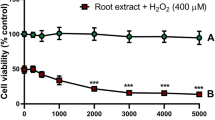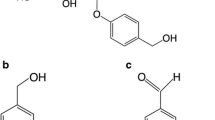Abstract
Synedrella nodiflora (SNE) has been used traditionally for many neurological conditions and some of these neuroactive effects have been scientifically substantiated. The usefulness of SNE in depression has however not been investigated despite the availability of data in other disease models indicating it may be useful. The present study therefore examined the effect of SNE in acute murine models of depression and the possible mechanisms mediating its activities in these models. Preliminary qualitative phytochemical and high performance liquid chromatography (HPLC) screening were conducted on SNE. The behavioural effects of SNE (100, 300 and 1000 mg/kg) pre-treated mice were examined in the forced swimming (FST) and tail suspension (TST) tests. Behavioural events such as mobility (swimming, climbing, curling and climbing), and immobility, were scored. The possible involvement of monoamines in the effects of SNE was assessed in the TST by pre-treating mice with α-methyldopa, reserpine and para-chlorophenylalanine (pCPA) in separate experiments. Flavonoids, tannins, saponins, alkaloids, cardiac glycosides, coumarins, triterpenes, sterols, anthraquinones and phenolic compounds were present in SNE. HPLC analysis revealed the presence of two major constituents observed at retention times 42.56 and 46.51 min, with percentage composition of 45.72% and 36.88% respectively. SNE significantly reduced immobility scores in both FST and TST, suggesting antidepressant effects. The antidepressant properties of SNE were reversed by the pre-treatment of α-methyldopa, reserpine and pCPA, suggesting a possible involvement of monoamines (noradrenaline and serotonin) in its mechanism(s) of actions. SNE exhibits antidepressant effects, possibly mediated through an interplay of enhancement of noradrenergic and serotoninergic mechanisms.








Similar content being viewed by others
References
Adjei S, Amoateng P, Osei-Safo D, Ahedor B, N’guessan BB, Addo P, Asiedu-Gyekye IJ (2014a) Biochemical and haematological changes following an acute toxicity study of a hydro-ethanolic whole plant extract of Synedrella nodiflora (L) Gaertn in male Sprague-Dawley rats. J Med Biomed Sci 3:31–37
Adjei S, Amoateng P, Osei-Safo D, Sasu C, N’guessan BB, Addo P, Asiedu-Gyekye IJ (2014b) Sub-acute toxicity of a hydro-ethanolic whole plant extract of Synedrella nodiflora (L) Gaertn in rats. Int J Green Pharmacy 8:271–275
Adongo DW, Kukuia KKE, Mante PK, Ameyaw EO, Woode E (2015) Antidepressant-like effect of the leaves of Pseudospondias microcarpa in mice: evidence for the involvement of the serotoninergic system, NMDA receptor complex, and nitric oxide pathway. Biomed Res Int 2015:1–15
Amoateng P, Assumeng Koffuor G, Sarpong K, Oteng Agyapong K (2011) Free radical scavenging and anti-lipid Peroxidative effects of a hydro-ethanolic extract of the whole plant of Synedrella nodiflora (L.) Gaertn (Asteraceae). Free Radicals and Antioxid 1:70–78. https://doi.org/10.5530/ax.2011.3.10
Amoateng P, Woode E, Kombian SB (2012) Anticonvulsant and related neuropharmacological effects of the whole plant extract of Synedrella nodiflora (L.) Gaertn (Asteraceae). J Pharm & Bio Sci 4:140–148. https://doi.org/10.4103/0975-7406.94816
Amoateng P, Adjei S, Osei-Safo D, Ameyaw EO, Ahedor B, N'Guessan BB, Nyarko AK (2015) A hydro-ethanolic extract of Synedrella nodiflora (L.) Gaertn ameliorates hyperalgesia and allodynia in vincristine-induced neuropathic pain in rats. J Basic Clin Physiol Pharmacol 26:383–394. https://doi.org/10.1515/jbcpp-2014-0084
Amoateng P, Adjei S, Osei-Safo D, Ahedor B, Mahmood SA, N'guessan B, Asiedu-Gyekye IJ, Nyarko AK (2016) Long-term continuous administration of a hydro-ethanolic extract of Synedrella nodiflora (L) Gaertn in male Sprague-Dawley rats: biochemical, haematological and histopathological changes. Ghana Med J 50:163–171
Amoateng P, Adjei S, Osei-Safo D, Kukuia KKE, Bekoe EO, Karikari TK, Kombian SB (2017a) Extract of Synedrella nodiflora (L) Gaertn exhibits antipsychotic properties in murine models of psychosis. BMC Complement Altern Med 17:389. https://doi.org/10.1186/s12906-017-1901-2
Amoateng P, Adjei S, Osei-Safo D, Kukuia KKE, Kretchy IA, Sarkodie JA, N’Guessan BB (2017b) Analgesic effects of a hydro-ethanolic whole plant extract of Synedrella nodiflora (L.) Gaertn in paclitaxel-induced neuropathic pain in rats. BMC Res Notes 10:226. https://doi.org/10.1186/s13104-017-2551-7
Berrocoso E, Ikeda K, Sora I, Uhl GR, Sánchez-Blázquez P, Mico JA (2013) Active behaviours produced by antidepressants and opioids in the mouse tail suspension test. Int J Neuropsychopharmacol 16:151–162
Blier P, de Montigny C, Chaput Y (1987) system by antidepressant treatments: implications for the therapeutic response in major depression. J Cin Psychopharmacol 7:24S
Cardoso CC, Lobato KR, Binfaré RW, Ferreira PK, Rosa AO, Santos ARS, Rodrigues ALS (2009) Evidence for the involvement of the monoaminergic system in the antidepressant-like effect of magnesium. Prog Neuro-Psychopharmacol Biol Psychiatry 33:235–242
Chandra SR, Manohar VR, Rao SN (2012) Antidepressant activity of aqueous extract of fruits of Terminal chebula in rats. Int J Pharm Pharm Sci 4:449–451
Cryan JF, Mombereau C, Vassout A (2005) The tail suspension test as a model for assessing antidepressant activity: review of pharmacological and genetic studies in mice. Neurosci Biobehav Rev 29:571–625. https://doi.org/10.1016/j.neubiorev.2005.03.009
Dang H, Chen Y, Liu X, Wang Q, Wang L, Jia W, Wang Y (2009) Antidepressant effects of ginseng toatl saponins in the forced swimming test and chronic mild stress models of depression. Prog Neuro-Psychopharmacol Biol Psychiatry 33:1417–1424
Delgado PL, Miller HL, Salomon RM, Licinio J, Krystal JH, Moreno FA, Heninger GR, Charney DS (1999) Tryptophan-depletion challenge in depressed patients treated with desipramine or fluoxetine: implications for the role of serotonin in the mechanism of antidepressant action. Biol Psychiatry 46:212–220
Dunner DL (2004) Pharmacotherapy of depression. Am J Psychiatr 161:2146–a-2147
Fukui M, Rodriguiz RM, Zhou J, Jiang SX, Phillips LE, Caron MG, Wetsel WC (2007) Vmat2 heterozygous mutant mice display a depressive-like phenotype. J Neurosci 27:10520–10529
Gourion D (2008) Antidepressants and their onset of action: a major clinical, methodological and pronostical issue. Encéphale 34:73–81
Guillot TS, Miller GW (2009) Protective actions of the vesicular monoamine transporter 2 (VMAT2) in monoaminergic neurons. Mol Neurobiol 39:149–170
Ji J, McDermott J, Dluzen D (2007) Sex differences in K+−evoked striatal dopamine output from Superfused striatal tissue fragments of reserpine-treated CD-1 mice. J Neuroendocrinol 19:725–731
Kalia M (2005) Neurobiological basis of depression: an update. Metabolism 54:24–27
Kessler CK, Bromet EJ (2013) The epidemiology of depression across cultures. Annu Rev Public Health 34:119–138. https://doi.org/10.1146/annurev-publhealth-031912-114409
Kukuia KK, Mante PK, Woode E, Ameyaw EO, Adongo DW (2014) Antidepressant effects of Mallotus oppositifolius in acute murine models. ISRN Pharmacol 2014:1–12
Kukuia KE, Asiedu-Gyekye IJ, Woode E, Biney RP, Addae E (2015) Phytotherapy of experimental depression: Kalanchoe integra Var. Crenata (Andr.) Cuf leaf extract. J Pharm Bioallied Sci 7:26–31
Lantz MS, Buchalter E, Giambanco V (1999) St. John's wort and antidepressant drug interactions in the elderly. J Geriatr Psychiatry Neurol 12:7–10
López-Rubalcava C, Lucki I (2000) Strain differences in the behavioral effects of antidepressant drugs in the rat forced swimming test. Neuropsychopharmacol 22:191–199
Lucki I (1997) The forced swimming test as a model for core and component behavioral effects of antidepressant drugs. Behav Pharmacol 8:523–532
Lutz P-E, Kieffer BL (2013) Opioid receptors: distinct roles in mood disorders. Trends Neurosci 36:195–206
Ma-Li W, Licinio J (2001) Research and treatment approaches to depression. Nat Rev Neurosci 2:343
Maria Michel T, Pulschen D, Thome J (2012) The role of oxidative stress in depressive disorders. Curr Pharm Des 18:5890–5899
Mayberg HS (1994) Frontal lobe dysfunction in secondary depression. J Neuropsychiatry Clin Neurosci 6:428–428
Metzger RR, Brown JM, Sandoval V, Rau KS, Elwan MA, Miller GW, Hanson GR, Fleckenstein AE (2002) Inhibitory effect of reserpine on dopamine transporter function. Eur J Pharmacol 456:39–43
Millan MJ (2004) The role of monoamines in the actions of established and “novel” antidepressant agents: a critical review. Eur J Pharmacol 500:371–384
Mshana NR et al. (2000) Traditional medicine and pharmacopoeia. Contribution to the revision of ethnobotanical and floristic studies in Ghana. Scientific, Technical and research Commission of the Organization of African Unity. Scientific, Technical and Research Commission (OAU),
Nestler EJ, Barrot M, DiLeone RJ, Eisch AJ, Gold SJ, Monteggia LM (2002) Neurobiology of depression. Neuron 34:13–25
O’Leary OF, Bechtholt AJ, Crowley JJ, Hill TE, Page ME, Lucki I (2007) Depletion of serotonin and catecholamines block the acute behavioral response to different classes of antidepressant drugs in the mouse tail suspension test. Psychopharmacol 192:357–371
Page ME, Detke MJ, Dalvi A, Kirby LG, Lucki I (1999) Serotonergic mediation of the effects of fluoxetine, but not desipramine, in the rat forced swimming test. Psychopharmacol (Berl) 147:162–167
Petit-Demouliere B, Chenu F, Bourin M (2005) Forced swimming test in mice: a review of antidepressant activity. Psychopharmacol 177:245–255
Poleszak E, Szewczyk B, Kędzierska E, Wlaź P, Pilc A, Nowak G (2004) Antidepressant- and anxiolytic-like activity of magnesium in mice. Pharmacol Biochem Behav 78:7–12
Porsolt R, Bertin A, Jalfre M (1977) Behavioral despair in mice: a primary screening test for antidepressants. Arch Int Pharmacodyn Ther 229:327–336
Reneric J-P, Lucki I (1998) Antidepressant behavioral effects by dual inhibition of monoamine reuptake in the rat forced swimming test. Psychopharmacol 136:190–197
Rénéric J-P, Bouvard M, Stinus L (2001) Idazoxan and 8-OH-DPAT modify the behavioral effects induced by either NA, or 5-HT, or dual NA/5-HT reuptake inhibition in the rat forced swimming test. Neuropsychopharmacol 24:379–390
Ripoll N, David DJP, Dailly E, Hascoët M, Bourin M (2003) Antidepressant-like effects in various mice strains in the tail suspension test. Behav Brain Res 143:193–200. https://doi.org/10.1016/S0166-4328(03)00034-2
Ruhé HG, Huyser J, Swinkels JA, Schene AH (2006) Switching antidepressants after a first selective serotonin reuptake inhibitor in major depressive disorder: a systematic review. J Clin Psychiatry 67:1836–1855
Steru L, Chermat R, Thierry B, Simon P (1985) The tail suspension test: a new method for screening antidepressants in mice. Psychopharmacol 85:367–370
Sun Y, Meng F, Chen ZH, Zhang QW, Qiao W, Z W, Qin X (2013) Antidepressant-like effects of Total alkaloids from semen Zizyphi Sponosae in mice models of depression. Pharmacologia 4
Tian J, Zhang F, Cheng J, Guo S, Liu P, Wang H (2014) Antidepressant-like activity of adhyperforin, a novel constituent of Hypericum perforatum L. Sci Rep 4. https://doi.org/10.1038/srep05632
W.H.O. (2012) World suicide prevention day 2012. http://www.who.int/mediacentre/events/annual/world_suicide_prevention_day/en/Accessed 16.62012
Wijaya S, Nee TK, ** KT, Hon LK, San LH, Wiart C (2011) Antibacterial and antioxidant activities of Synedrella nodiflora (L.) Gaertn. (Asteraceae). J Complement Integr Med 8. https://doi.org/10.2202/1553-3840.1499
Wimalasena K (2011) Vesicular monoamine transporters: structure-function, pharmacology, and medicinal chemistry. Med Res Rev 31:483–519
Woode E, Amidu N, Owiredu W, Boakye-Gyasi E, Ansah C, Duwiejua M (2009a) Antidepressant-like effects of an ethanolic extract of Sphenocentrum jollyanum Pierre roots in mice. IJP-Int J Pharmacol 5:22–29
Woode E, Amoateng P, Ansah C, Duwiejua M (2009b) Anti-nociceptive effects of an ethanolic extract of the whole plant of Synedrella nodiflora (L.) Gaertn in mice: involvement of Adenosinergic mechanisms. J Pharmacol Toxicol 4:17–29. https://doi.org/10.3923/jpt.2009.17.29
Woode E, Amoateng P, WMK A (2011) Ethopharmacological analysis of the effects of the whole plant extract of (L) Gaertn (Asteraceae) in murine models. Der Pharmacia Sinica 2:54–67
Acknowledgements
The contributions of Mary Dufie and Nigel Osei Amoateng during the experimentation are greatly appreciated. We are also grateful to the staff of the Animal Experimentation, NMIMR, Legon, Accra for their technical assistance.
Funding
This research was supported by the International Foundation for Science, Stockholm, Sweden, through a grant (# F/5191–1) to Dr. Patrick Amoateng. The research paper was supported by the University of Ghana-Building a New Generation of Academics in Africa (BANGA-Africa) project with funding from the Carnegie Corporation of New York.
Author information
Authors and Affiliations
Corresponding authors
Ethics declarations
Conflict of interest
There is no known conflict of interest in this manuscript.
Ethical approval
All animal procedures and techniques used in this studies were approved by the Scientific and Technical Committee (STC) of the Noguchi Memorial Institute for Medical Research [reference number STC-6 (1) 2012–13] and also by the Noguchi Institutional Animal Care and Use Committee (NIACUC), College of Health Sciences, University of Ghana with protocol number NIACUC-2012-01-1E. The experiments conducted involving laboratory animals were done in accordance with described by the Guide for the care and use of laboratory animals, National Research Council of the National Academies, NIH, US and also as per the Noguchi Institutional Care and Use of Laboratory Guidelines.
Additional information
Key message: Extract of Synedrella nodiflora exhibits antidepressant effects.
Rights and permissions
About this article
Cite this article
Amoateng, P., Kukuia, K.K.E., Mensah, J.A. et al. An extract of Synedrella nodiflora (L) Gaertn exhibits antidepressant properties through monoaminergic mechanisms. Metab Brain Dis 33, 1359–1368 (2018). https://doi.org/10.1007/s11011-018-0244-0
Received:
Accepted:
Published:
Issue Date:
DOI: https://doi.org/10.1007/s11011-018-0244-0




